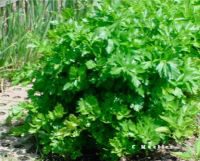Celery
 Celery is a cool season biennial. Most people find celery a disappointing garden vegetable because the stalks are too strong in flavor and somewhat dry and pithy. In the wild, celery is a bog plant. Here, in east San Diego County, one can find wild celery growing along the Sweetwater River Channel and other drainage ditches where its root is constantly wet. In the garden it needs almost the same conditions to be crisp and tender, plus the blanching of the stalks (we will go into that later). Soil for celery should have a high moisture holding capacity. Organically rich soil is important. Celery is also a heavy feeder and needs additional applications of a high nitrogen and phosphorus fertilizer (16 - 20 - 0) during the growing season. A two year study (spring 1984 - 1985) at the South Coast Field Station (UC Irvine) has shown phosphorus significantly influences maturity and quality in celery.
Celery is a cool season biennial. Most people find celery a disappointing garden vegetable because the stalks are too strong in flavor and somewhat dry and pithy. In the wild, celery is a bog plant. Here, in east San Diego County, one can find wild celery growing along the Sweetwater River Channel and other drainage ditches where its root is constantly wet. In the garden it needs almost the same conditions to be crisp and tender, plus the blanching of the stalks (we will go into that later). Soil for celery should have a high moisture holding capacity. Organically rich soil is important. Celery is also a heavy feeder and needs additional applications of a high nitrogen and phosphorus fertilizer (16 - 20 - 0) during the growing season. A two year study (spring 1984 - 1985) at the South Coast Field Station (UC Irvine) has shown phosphorus significantly influences maturity and quality in celery.
If you have good luck with starting your own seedlings, try growing this challenging transplant. It takes 8 - 10 weeks for seedlings to become large enough to set out. Unfortunately, there are several problems involved. Seeds in any batch will sprout at different times; seeds need light for germinating and its small seed and seedlings must never go below 55 degrees or the cold will trigger the plants to bolt later To overcome some of these problems, commercial growers pre-sprout seed by soaking in warm water (65 - 70 degrees) day and night.
After all of this you may just want to buy your plants from a nursery. If so, be sure to get young plants. Set them out at the same depth they were in containers. Space plants 10 - 12 inches apart in rows 24 inches apart, or on raised beds with flat tops and an irrigation furrow down the middle. Set plants on opposite shoulders. Shelter plants for a few days, if it is hot.
BLANCHING. Blanch by using a half-gallon paper milk carton with the top and bottom cut off. Slide the carton over the young transplant as soon as you plant it in the ground. The celery will grow upright inside the carton and be cream colored and tender.
If you have an earwig problem, begin trapping them right away as they will use the enclosed plant as a hiding place during the day. As the plant becomes mature and grows out of the top of the carton, harvest stalks either by cutting off outer stalks, as needed, or dig up the whole plant. Cut off root, trim leaves and outer stalks. It will look just like the heads from the supermarket.
Also check out ...
http://vric.ucdavis.edu/veg_info_crop/celery.htm
http://www.ipm.ucdavis.edu/PMG/selectnewpest.celery.html
Planting Dates
Coastal:
Seeds can be planted from September to April.
Inland:
Seeds can be planted from September to March.

